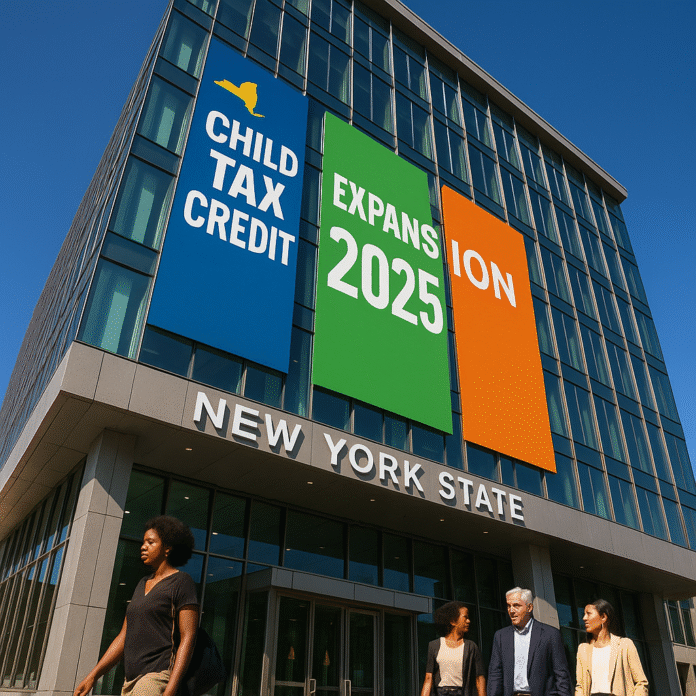New York State has announced the largest expansion of its Child Tax Credit program in history, providing significant financial relief to families across the state. The expanded credit offers increased amounts per child, broader eligibility criteria, and simplified application procedures—all designed to reduce child poverty and support diverse family structures.
Overview of the Expanded Credit
The new provisions for the Child Tax Credit, effective for the 2025 tax year, mark a historic change in state policy. Key aspects of the expansion include an increase in the maximum credit per child, with eligible families receiving up to $1,000 for children under the age of four and $500 for children aged four to 16. In addition to these dollar-amount increases, the program now covers a broader range of families by easing income limitations and removing previous restrictions that excluded certain low-income households. The expanded credit is fully refundable, ensuring that even families with low or zero state tax liability can benefit.
Eligibility Criteria and Special Cases
To qualify for the expanded credit, claimants must be New York residents for all or part of the tax year and claim the child as a dependent on their state tax return. The following outlines the general eligibility requirements along with important exceptions and special cases:
- Families must meet specified income thresholds, with full credits available to married filers earning up to approximately $110,000, and eligibility phased out gradually for higher incomes up to $170,000.
- The qualifying child must be under 17 years old at year-end, live with the claimant for more than half the year, and possess a valid Social Security Number or Individual Taxpayer Identification Number.
- Non-citizens may also benefit provided the child meets criteria as a U.S. citizen, national, or resident alien and all related documentation (SSNs or ITINs) is in order.
- Part-year residents can claim the credit by filing Form IT-203. The credit may be prorated based on the duration of residency in New York.
- In shared custody situations, only one parent (typically the one who claims the child as a dependent on their federal tax return) can claim the credit.
- Expanded benefits now reach traditionally underserved groups, including families with very low incomes—ensuring that all eligible children receive assistance regardless of the state tax liability.
How to Claim the Expanded Credit
Families can claim the New York Child Tax Credit when filing their tax returns for the 2025 tax year. The application process is integrated with the state tax filing procedure:
- File a New York State tax return using Form IT-201 (for full-year residents) or IT-203 (for part-year residents). Even families with no state tax liability should file to receive the refundable credit.
- Complete Form IT-213, dedicated to the Child Tax Credit, and include accurate details for each qualifying child—this includes the child’s full name, Social Security Number, and date of birth.
- Carefully report adjusted gross income (AGI) since the credit is partially determined by income levels. Direct deposit is recommended for quicker refund processing.
- Ensure that all supporting documents such as proof of residency, income statements (W-2s or 1099s), and identification documents are in order to avoid delays.
State agencies and tax professionals are expected to distribute clear guidance and online resources to assist families in navigating the application process.
Impact on Families and the Broader Community
The expanded credit is anticipated to have far-reaching effects on New York families and the state’s overall economy:
- Financial Relief: The credit nearly doubles the average benefit per family—from approximately $472 under the previous program to around $943. Households with multiple children could see substantial annual increases in support.
- Reduction in Child Poverty: Experts predict an 8.2% decrease in the state’s child poverty rate as direct financial support helps cover essential expenses, contributing to improved nutrition, education, and overall wellbeing for children.
- Economic Boost: Increased household spending is expected to stimulate local economies, particularly in low-income communities where every dollar directly impacts quality of life.
- Inclusive Support: Advocacy groups have lauded the policy for its inclusivity, ensuring that immigrant families and those facing shared custody challenges are not left behind.
Governor Kathy Hochul, alongside various advocacy groups and state agencies, underscores that the expansion is part of a broader effort to improve overall affordability in New York, comprising additional measures such as inflation relief and complementary tax cuts for the middle class.
Legislative Timeline and Key Dates
The journey to this historic expansion followed a clear legislative timeline:
- February 14, 2025: Assembly Bill A5549 was introduced in the New York State Assembly, proposing significant increases to the credit.
- May 9, 2025: Governor Kathy Hochul signed the expanded credit into law as part of the FY 2026 State Budget. The signing ceremony emphasized the importance of reducing child poverty and strengthening economic security for families.
- Effective Date: The provisions take effect for the 2025 tax year, with families beginning to claim the credit when filing their tax returns in early 2026.
- Additional Deadlines: Families should verify that their 2024 tax returns are accurately completed since eligibility for the full credit is based on 2024 income information. Refunds, including any advance payment options, are expected between March and May 2026.
Alongside the Child Tax Credit expansion, the FY 2026 State Budget includes initiatives such as free school meals for K-12 students and additional middle-class tax cuts, further easing the financial burden on New York families.
The expanded New York Child Tax Credit represents a transformative policy update designed to enhance family financial security, reduce child poverty, and boost overall economic growth. By offering increased cash benefits, broader eligibility, and a simplified application process, the state is committed to ensuring that every child benefits from this historic initiative. Families are encouraged to review the eligibility requirements, gather necessary documentation, and file their tax returns promptly to take full advantage of the expanded credit in 2025.




